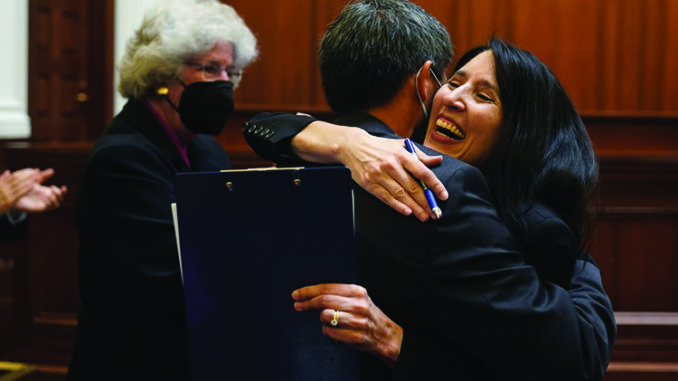
September 15th marked the beginning of Hispanic Heritage Month, an occasion to celebrate the history, culture, and contributions of Hispanic Californians. At the Haas, Jr. Fund, we are taking this moment to recognize and reflect on Latino leadership. We’re also weighing what more we can do to lift up and support Latino leaders in a state where Latinos are 39% of the population.
The lack of Latino representation in key leadership positions in California is an ongoing problem that the Haas, Jr. Fund and our partners are continually working to address. At the same time, there has been tremendous recent progress that we can be proud of.
Last month, for example, Governor Gavin Newsom nominated Associate Justice Patricia Guerrero to be the first Latino or Latina to be chief justice of California Supreme Court. The child of Mexican immigrants, Justice Guerrero became the first Latina to serve on the state’s highest court when she was confirmed in March, and voters will have the opportunity to ratify her appointment as chief justice in November.
In August, Governor Newsom nominated Dr. Diana Ramos to be the new California surgeon general. Dr. Ramos grew up in South L.A., raised by her single mom, and grew up to become the first Latino or Latina president of the Orange County Medical Association. She plans to bring a focus on a healthier, more equitable future for Californians to her new role.
When it comes to elected office, the state redistricting process completed last year created many new opportunities for California to increase Latino leadership. According to an analysis of the final redistricting maps, the number of Latino majority congressional districts—or districts where Latinos make up a majority of eligible voters—has increased from 10 to 16. The number of Latino majority districts in the state legislature, where Latino representation is already at record highs, also went up. In the state senate, the number of Latino majority districts increased from seven to 10, and the number of Latino majority assembly districts increased from 17 to 22.
The redistricting process also delivered countless other wins for Latino representation at the local level. For example, in Orange County, a board of supervisors map that will for the first time create a Latino majority district was approved, creating an historic opportunity for Latinos in that rapidly diversifying county.
And in July, the state legislature invested in Latina leadership in a major way. Championed by the Latino Caucus, the final state budget included a $15 million allocation to the Latino Public Policy Institute, meant to support the launch of the Latina Futures, 2050 Lab, which will seek to build the pipeline for Latina academic and policy leaders. As recent research from Hispanas Organized for Political Equality demonstrated, Latinas tend to lead with racial equity and economic justice in mind, a philosophy and approach to leadership that will benefit all Californians.
Barriers to Latino Leadership
Despite this progress, we know that significant barriers remain to Latino leadership. For example, while redistricting created new opportunities for Latino leadership in many places, there are still entrenched forces seeking to protect incumbents by diluting the votes of Latinos. Take Riverside County, where advocates have had to turn to the courts to seek fair representation for Latinos, after being denied two Latino majority districts, despite making up a majority of the county population.
A recent report from the Latino Public Policy Institute highlighted that despite recent progress, Latinos remain significantly underrepresented among executive appointees. For example, they make up only 12% of the Governor’s cabinet, and 19% of executive board and commission appointments.
Latinos also remain underrepresented in the courts. An analysis found that four majority-Latino counties did not have a single Latino judge. There were also 13 counties that had at least a 30-point percentage gap between the percentage of Latinos in the county and the percentage of Latino judges.
What We Are Doing
Underlying all of these statistics on Latino leadership in California is the fact that Latinos remain underrepresented at the ballot box. While turnout was up among Latino voters in 2020 compared to 2016, the gap between Latino voters and other groups actually increased. In other words, Latinos were more underrepresented at the ballot box than in the previous presidential election. A recent study suggests that election reforms adopted by California which limit in-person voting opportunities are contributing to lower Latino turnout.
At the Haas Jr., Fund, we are exploring policies, programs, supports, and research to change these dynamics. For example:
We supported redistricting efforts seeking to ensure Latino representation.
We are seeking to advance strategies for improving language access in our elections.
We are exploring ways to reform policies that disenfranchise or dilute the voting power of Latinos.
We are funding research to expand policies that will better serve Latino voters.
We are partnering with Latino-led organizations, as well as other groups focused on cross-racial solidarity, as they make the case for equity in leadership and representation at all levels.
We are investing in capacity building and training that can help develop the next generation of Latino leaders.
Latinos make up a plurality of Californians—and an even bigger share of California’s young people. It is critical that Latinos have their rightful power and voice to help shape the future of their communities and their state. Let’s celebrate Latino contributions to California this month, but let’s also evaluate what more we can do to ensure Latinos are represented in positions to influence what comes next for California.



Be the first to comment